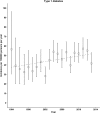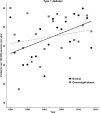Body Mass Index and Incident Type 1 and Type 2 Diabetes in Children and Young Adults: A Retrospective Cohort Study
- PMID: 29264507
- PMCID: PMC5686575
- DOI: 10.1210/js.2017-00044
Body Mass Index and Incident Type 1 and Type 2 Diabetes in Children and Young Adults: A Retrospective Cohort Study
Abstract
Context: Little is known about the association between obesity and temporal trends in the incidence of diabetes in children and young adults.
Objective: We examined the recent incidence of types 1 and 2 diabetes in relation to a high body mass index (BMI) in UK children and young adults.
Design: Cohort and nested case-control.
Setting: A total of 375 general practices that contribute to the UK Clinical Practice Research Datalink (CPRD).
Participants: A total of 369,362 participants aged 2 to 15 years at BMI measurement in CPRD from 1994 to 2013.
Intervention: None.
Main outcome measures: Incident type 1 diabetes (T1D) and type 2 diabetes (T2D) diagnoses up to age 25 years.
Results: A total of 654 incident cases of T2D and 1318 T1D cases were found. The incidence of T2D per 100,000 persons annually increased from 6.4 in 1994 to 1998 to 33.2 in 2009 to 2013; and that for T1D increased from 38.2 to 52.1 per 100,000 persons during the same period. The incidence of T2D increased in both overweight (85th to 95th percentile for age- and sex-specific BMI; P = 0.01) and obese (≥95th percentile; P < 0.01) individuals from 1994 to 2013. Obese individuals, who constituted 47.1% of T2D cases, had a markedly greater risk of incident T2D [odds ratio, 3.75; 95% confidence interval (CI), 3.07 to 4.57], with an incidence rate ratio of 4.33 (95% CI, 3.68 to 5.08) compared with the normal BMI category. No positive linear association was found between obesity (greater BMI) and incident T1D cases.
Conclusions: Increasing obesity has contributed to the increasing incidence of T2D but not T1D among UK children and young adults, with a fourfold greater risk of developing T2D in obese individuals.
Keywords: adolescence; body mass index; children; diabetes; epidemiology; obesity.
Figures




References
-
- Ng M, Fleming T, Robinson M, Thomson B, Graetz N, Margono C, Mullany EC, Biryukov S, Abbafati C, Abera SF, Abraham JP, Abu-Rmeileh NM, Achoki T, AlBuhairan FS, Alemu ZA, Alfonso R, Ali MK, Ali R, Guzman NA, Ammar W, Anwari P, Banerjee A, Barquera S, Basu S, Bennett DA, Bhutta Z, Blore J, Cabral N, Nonato IC, Chang JC, Chowdhury R, Courville KJ, Criqui MH, Cundiff DK, Dabhadkar KC, Dandona L, Davis A, Dayama A, Dharmaratne SD, Ding EL, Durrani AM, Esteghamati A, Farzadfar F, Fay DF, Feigin VL, Flaxman A, Forouzanfar MH, Goto A, Green MA, Gupta R, Hafezi-Nejad N, Hankey GJ, Harewood HC, Havmoeller R, Hay S, Hernandez L, Husseini A, Idrisov BT, Ikeda N, Islami F, Jahangir E, Jassal SK, Jee SH, Jeffreys M, Jonas JB, Kabagambe EK, Khalifa SE, Kengne AP, Khader YS, Khang YH, Kim D, Kimokoti RW, Kinge JM, Kokubo Y, Kosen S, Kwan G, Lai T, Leinsalu M, Li Y, Liang X, Liu S, Logroscino G, Lotufo PA, Lu Y, Ma J, Mainoo NK, Mensah GA, Merriman TR, Mokdad AH, Moschandreas J, Naghavi M, Naheed A, Nand D, Narayan KM, Nelson EL, Neuhouser ML, Nisar MI, Ohkubo T, Oti SO, Pedroza A, Prabhakaran D, Roy N, Sampson U, Seo H, Sepanlou SG, Shibuya K, Shiri R, Shiue I, Singh GM, Singh JA, Skirbekk V, Stapelberg NJ, Sturua L, Sykes BL, Tobias M, Tran BX, Trasande L, Toyoshima H, van de Vijver S, Vasankari TJ, Veerman JL, Velasquez-Melendez G, Vlassov VV, Vollset SE, Vos T, Wang C, Wang X, Weiderpass E, Werdecker A, Wright JL, Yang YC, Yatsuya H, Yoon J, Yoon SJ, Zhao Y, Zhou M, Zhu S, Lopez AD, Murray CJ, Gakidou E. Global, regional, and national prevalence of overweight and obesity in children and adults during 1980-2013: a systematic analysis for the Global Burden of Disease Study 2013. Lancet. 2014;384:766–781. - PMC - PubMed
-
- Skinner AC, Perrin EM, Moss LA, Skelton JA. Cardiometabolic risks and severity of obesity in children and young adults. N Engl J Med. 2015;373:1307–1317. - PubMed
-
- Department of Health & Chief Medical Officer. Annual report of the Chief Medical Officer 2002. 2003. Available at: http://webarchive.nationalarchives.gov.uk/+/www.dh.gov.uk/en/Publication.... Accessed 8 April 2016.
-
- World Health Organization Obesity and overweight. Fact sheet number 311. Geneva: World Health Organization; 2015.
-
- Craig R, Fuller E, Mindell J, eds. Health Survey for England, 2014. Chapter 10: Children's BMI, Overweight and Obesity. NHS Digital (formerly, Health and Social Care Information Centre); publication date 16 December 2015. Available at: http://content.digital.nhs.uk/catalogue/PUB19295. Accessed: 15 April 2016.
LinkOut - more resources
Full Text Sources
Other Literature Sources
